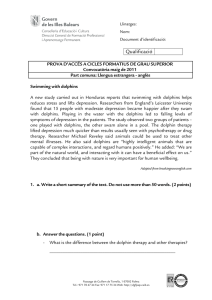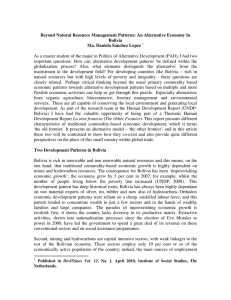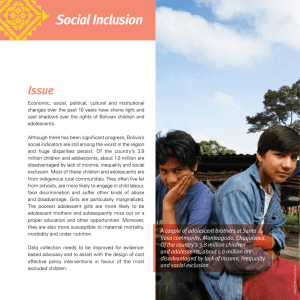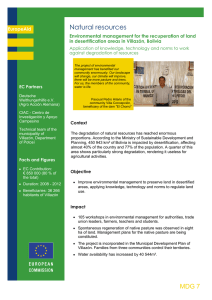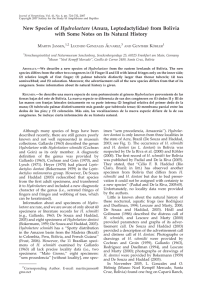the bolivian river dolphin in the tijamuchi
Anuncio
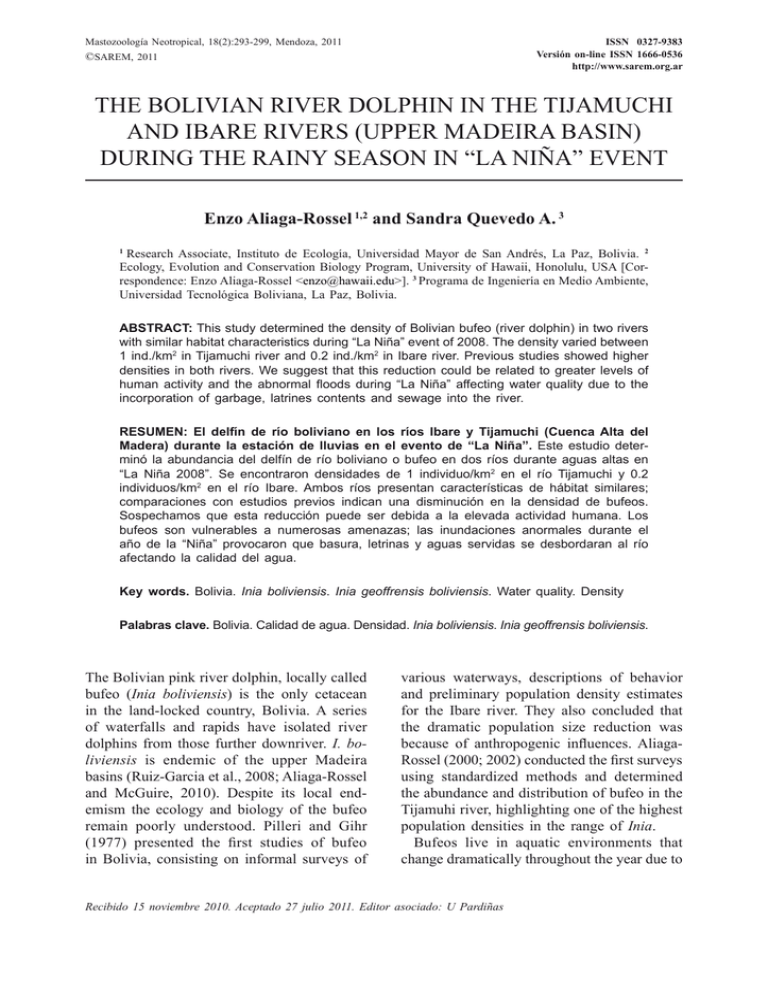
ISSN 0327-9383 Versión on-line ISSN 1666-0536 http://www.sarem.org.ar Mastozoología Neotropical, 18(2):293-299, Mendoza, 2011 ©SAREM, 2011 THE BOLIVIAN RIVER DOLPHIN IN THE TIJAMUCHI AND IBARE RIVERS (UPPER MADEIRA BASIN) DURING THE RAINY SEASON IN “LA NIÑA” EVENT Enzo Aliaga-Rossel 1,2 and Sandra Quevedo A. 3 Research Associate, Instituto de Ecología, Universidad Mayor de San Andrés, La Paz, Bolivia. 2 Ecology, Evolution and Conservation Biology Program, University of Hawaii, Honolulu, USA [Correspondence: Enzo Aliaga-Rossel <enzo@hawaii.edu>]. 3 Programa de Ingeniería en Medio Ambiente, Universidad Tecnológica Boliviana, La Paz, Bolivia. 1 ABSTRACT: This study determined the density of Bolivian bufeo (river dolphin) in two rivers with similar habitat characteristics during “La Niña” event of 2008. The density varied between 1 ind./km2 in Tijamuchi river and 0.2 ind./km2 in Ibare river. Previous studies showed higher densities in both rivers. We suggest that this reduction could be related to greater levels of human activity and the abnormal floods during “La Niña” affecting water quality due to the incorporation of garbage, latrines contents and sewage into the river. RESUMEN: El delfín de río boliviano en los ríos Ibare y Tijamuchi (Cuenca Alta del Madera) durante la estación de lluvias en el evento de “La Niña”. Este estudio determinó la abundancia del delfín de río boliviano o bufeo en dos ríos durante aguas altas en “La Niña 2008”. Se encontraron densidades de 1 individuo/km2 en el río Tijamuchi y 0.2 individuos/km2 en el río Ibare. Ambos ríos presentan características de hábitat similares; comparaciones con estudios previos indican una disminución en la densidad de bufeos. Sospechamos que esta reducción puede ser debida a la elevada actividad humana. Los bufeos son vulnerables a numerosas amenazas; las inundaciones anormales durante el año de la “Niña” provocaron que basura, letrinas y aguas servidas se desbordaran al río afectando la calidad del agua. Key words. Bolivia. Inia boliviensis. Inia geoffrensis boliviensis. Water quality. Density Palabras clave. Bolivia. Calidad de agua. Densidad. Inia boliviensis. Inia geoffrensis boliviensis. The Bolivian pink river dolphin, locally called bufeo (Inia boliviensis) is the only cetacean in the land-locked country, Bolivia. A series of waterfalls and rapids have isolated river dolphins from those further downriver. I. boliviensis is endemic of the upper Madeira basins (Ruiz-Garcia et al., 2008; Aliaga-Rossel and McGuire, 2010). Despite its local endemism the ecology and biology of the bufeo remain poorly understood. Pilleri and Gihr (1977) presented the first studies of bufeo in Bolivia, consisting on informal surveys of various waterways, descriptions of behavior and preliminary population density estimates for the Ibare river. They also concluded that the dramatic population size reduction was because of anthropogenic influences. AliagaRossel (2000; 2002) conducted the first surveys using standardized methods and determined the abundance and distribution of bufeo in the Tijamuhi river, highlighting one of the highest population densities in the range of Inia. Bufeos live in aquatic environments that change dramatically throughout the year due to Recibido 15 noviembre 2010. Aceptado 27 julio 2011. Editor asociado: U Pardiñas 294 Mastozoología Neotropical, 18(2):293-299, Mendoza, 2011 E Aliaga-Rossel and S Quevedo A. changes in season and precipitation. Therefore, during high levels of water, it commonly covers the floodplains as part of a natural cycle in the Amazon Basin (Sioli, 1984). However, a global current effect known as “La Niña” is characterized by unusual cold ocean temperatures in the tropical eastern Pacific Ocean in contrast to “El Niño”, characterized by warm ocean temperatures in the equatorial eastern Pacific (http://www.pmel.noaa.gov/tao/elnino/ faq.html#lanina). In Bolivia, both phenomena entail ecologic and economic disasters within tropical areas due to extreme droughts, flooding, and heavy rains. To date, there is no information on how these climatic events affect Neotropical aquatic mammals. This paper examines the abundance of the Bolivian bufeo in sections of the Tijamuchi and Ibare rivers during a rainy season with high level of water (high-water season) caused by “La Niña” event in 2008. In addition, we compared our results to previous densities obtained in years of normal precipitation in both Tijamuchi and Ibare rivers. This study has contributed to our knowledge on this unique cetacean of the Neotropical rivers. The study area (Ibare and Tijamuchi rivers) is situated in the Department of Beni, Bolivia (Fig. 1). These rivers are in the sub-basin of the Mamoré river, which then becomes the Madeira river in Brazil. The mean temperature in the area is 26.5ºC, and annual precipitation varies between 1200-2400 mm per year. The relative humidity ranges between 64% in August to 77% in January and February (Pouilli et al., 2004). The hydrologic regime is directly related to precipitation, with the highest water levels occurring between December and April, and the lowest water levels from June to October (Fig. 2). During high-water season much of the region is temporally flooded (Loubens et al., 1992; Poully et al., 2004). The diversity of fish and wildlife in the region is high with more than 380 species of fish reported, of which at least 40 species are consumed by humans (Pouilli et al., 2004). Riverbank vegetation is characteristic of tropical gallery forests and is interspersed with savannahs, some of which are natural and others are a result of deforestation for cattle ranches or human settlements. The Ibare and Tijamuchi rivers originate in the Llanos de Moxos (Fig. 1) and are classified as clear-waters from their headwaters to their middle reaches, which are characteristically low in nutrients and suspended sediments. However, downriver the Tijamuchi river receives input from small creeks that originate in white-waters and eventually is transformed into mixed clear- and white-water. Both the Ibare and Tijamuchi rivers are tributaries of the Mamoré river and both have a width of 50 to 110 m (Pilleri and Gihr, 1977; AliagaRossel, 2002). The main economic activities for human settlements along the riverbanks are cattle ranching, fishing, and small scale agriculture. Along the Tijamuchi, which has a lower human population, the main activity is cattle ranching. Along the Ibare river there are several human settlements because of their proximity to Trinidad, the main city in the region. There are five important ports on the Ibare river, resulting in high human activity and constant heavy boat traffic. Fieldwork took place in January 2008 during the high-water season (Fig. 2). Surveys consisted of two transects of the same river reach. The total distance surveyed was approximately 185 linear river km. Surveys were conducted between 07:30 h and 17:15 h, with a one-hour break around midday. A 100% strip-width transects was used to survey for bufeos using a vessel (40 horsepower hp) engine crewed by a boat driver and two observers travelling at a constant speed between 7-9 km/hr. Observer eye height was 2.5 m above water level. Double counts were avoided by maintaining communication between the observers. The observations were made from the front of the boat, and from the rear of the boat only to confirm number and size of bufeos. For each sighting, we registered: time, coordinates, vessel speed (with a GPS), and the width of the river by laser rangefinder. When a solitary bufeo or a group of bufeos was sighted, the number of dolphins per group was recorded. A group was defined as the number of animals observed in apparent aggregation. If we http://www.sarem.org.ar BOLIVIAN RIVER DOLPHIN DURING “LA NIÑA” 295 Fig. 1. Study site, Tijamuchi and Ibare rivers, tributaries of the Mamoré river, Mamoré sub basin, Bolivia. river with a sounding line (Table 1). In addition, based on our previous experience in the same rivers, we identified some aspects of river quality, such as solid waste or new settlements compared to previous surveys. We used Spearman rank correlations to determine correlations between human activities and distribution of bufeos, and Chi square test for comparison of samples. The number of bufeos observed was notably different in the two rivers. In total, we sighted 319 individuals, 189 in the Tijamuchi (density of 1.02 individual/km2) and 32 in the Ibare river (0.2 individual/km2). were unable to determine the exact number of individuals, the lowest reliable count was recorded (Mc Guire and Winnermiller, 1998; Aliaga-Rossel, 2002). We characterized the aquatic habitat every 2.5 km within the transects by measuring pH, water transparency using a Secchi disk, surface temperature at 0.5 m depth, and water depth measured in the middle of the 17 Precipitation mm 350 15 300 14 250 200 13 150 12 100 11 Precipitation (mm) Water Level (m) 400 Max River level 16 June May April March Jan Feb Dec Oct Nov Sept July 2007 Aug June May April March Jan Feb Dec Oct Nov Sept July 2006 Aug June May March Jan Feb 10 April 50 0 2008 Fig. 2. River water level (average in meters) and precipitation (mm) of the Ibare river region from January 2006 to June 2008. Precipitation data from Servicio Nacional de Meterología e Hidrología; river water level data from Ministerio Nacional de Defensa e Hidrografía Naval, La Paz, Bolivia. 296 Mastozoología Neotropical, 18(2):293-299, Mendoza, 2011 E Aliaga-Rossel and S Quevedo A. http://www.sarem.org.ar Table 1 Physical-chemical characteristics of the Ibare and Tijamuchi rivers during high water season in a La Niña year (2008). Average values are given. T°C = Temperature at ± 50 cm depth of the surface. River Ibare Tijamuchi Average (n=65) T (°C) Depth (m) Transparency (m) Width (m) pH 28.76 ± 3.79 30.33 ± 2.11 15.95 ± 1.52 13.02 ± 2.27 38.23 ± 4.91 40.25 ± 2.7 73.15 ± 19.8 77.58 ± 28.63 6.63 ± 0.22 6.72 ± 0.28 29.5 14.5 39.24 75.4 6.67 In total, 127 groups of bufeos were recorded (including solitary individuals). The group size was greater in the Tijamuchi river (13 individuals) and smaller in the Ibare river (4 individuals). This difference in size groups was statistically significant (X2 = 134.336, p = 0.00); 59% of the observations for Tijamuchi river, and 70% on the Ibare river were solitary individuals, then groups of two individuals (26% both rivers), including mother-calf pairs, followed by groups of three bufeos (7.8%). The largest group comprised 13 bufeos and was seen in the Tijamuchi river. The relationship between bufeo abundance and depth, temperature, ph was not statistically significant in either of the rivers. Finally, we found a highly significant but negative correlation between human activities and settlements and bufeo density (Spearman’s rank coefficient = -0.795, R2 = 0.632, p < 0,455). For the Tijamuchi river, the number of bufeos is relatively lower compared to previous studies in the area also during the rainy season (1.13 ind./km2) (Aliaga-Rossel, 2002). This reduction in density could be related to the region’s increasing human activity. The density we found in the Ibare river was lower than densities reported by Pilleri (1969) and Pilleri and Gihr (1977), 1.0 individual/km2, although their surveys were conducted during dry season when the number of observations of dolphins is normally higher. The Ibare river constitutes the main access to Trinidad city and contains several boat ports and human settlements along its shores, resulting in frequent and heavy boat traffic ranging from small vessels to large cargo boats (Poully et al., 2004). Furthermore, Naval Forces and other authorities do not regulate boat speed and traffic on either river. This may directly affect bufeo populations and may partially explain the low density. A negative relationship between boat traffic and dolphin populations has been observed with other species of river dolphins, such as Lipotes vexillifer and Platanista gangetica (Reeves et al., 2003). The dolphin densities in the Tijamuchi and Ibare rivers are still high compared to other areas (i. e. encounter rates of 0.13-1.50 individuals/km2 in Peru (McGuire, 2002), 0.28-0.40 individuals/km2 in the Colombian Amazon (Trujillo, 1992), 0.23-0.40 individuals/km2 in Ecuador (Utreras, 1995), 0.02-1.16 individuals/ km2 in Venezuela (McGuire and Winemiller, 1998), but are lower than the densities compared to 5.1 individuals/km2 for I. boliviensis in the Itenez river (Gómez et al., 2011). In both rivers the higher numbers of bufeos recorded were in river bends or curves and 50% of the observations were in the confluences of the river, although the number of confluences is very seasonal. Similar to Aliaga-Rossel (2000; 2002) during high waters, lower densities of bufeos were noted in confluences compared to other seasons, which may be caused by the flooding that inundates small confluences. We also observed a high number of dolphins in an oxbow lake close to the Tijamuchi river (n = 15); different studies showed these habitats to be important for residents or transient bufeos (McGuire and Henningsen, 2007; Ruiz Garcia et al., 2008). As in this study, Aliaga-Rossel (2000) also found most individuals were solitary (51%) and pairs were next most common (27%), and the largest group observed was also 13 individuals on the Tijamuchi river. These numbers are BOLIVIAN RIVER DOLPHIN DURING “LA NIÑA” relatively similar which might suggest stable populations over time and/or possible site fidelity or habitat requirements as suggested for I. boliviensis (Ruiz-Garcia et al., 2008) and for I. geoffrensis (Martin and da Silva, 2004; McGuire and Henninngssen, 2007). For the Ibare river, the highest group number observed (four individuals) was low compared with the Tijamuchi; this could be possibly caused by much boat traffic on this river and/or larger human settlements along its banks which perhaps disrupts bufeo social structure (Aliaga-Rossel et al., 2006). Therefore, differences in group size and bufeos numbers could be the result of a combination of different factors such as differences in habitat complexity, human impact and activity, water quality, or effects on food availability. We found no correlation between the density of bufeos and water characteristics, nor did the rivers differ with respect to the measured characteristics, even though Tijamuchi river might be richer in nutrients and prey than the clear-water Ibare river due to influx of white water from the Mamoré, and consequently it may be able to support larger groups of bufeos (Sioli, 1984; Aliaga-Rossel et al., 2006). Furthermore, studies elsewhere concluded that river dolphins abundance is not affected directly by characteristics such as depth of water, amount of dissolved nutrients, differences in pH, transparency, but it might be related to factors such as prey availability (Best and da Silva, 1989; McGuire and Winemiller, 1998; Aliaga-Rossel, 2002). We do not have quantitative data; however, we detected an increase in solid waste pollution; bottles, plastic bags and other solid residuals floating along these rivers that were not perceived on this scale before. Also, an upriver bridge is under construction and disorganized human new settlements have increased with waste dumped directly into the Tijamuchi river. Most of these activities increase the ecosystem degradation and might have effects on fish and dolphin population ecology. During a regular year (non Niño or Niña events), the high water season starts in November when water levels increase rapidly and areas of the river bank are flooded. Flooding 297 enters small channels which become accessible, opening a new habitat for bufeos where prey and individuals move into the inundated forest and around the numerous permanent or temporary lagoons. Consequently, the number of encounters in the main channel can be lower in this season, as observed for I. geoffrensis in Venezuela (McGuire and Winemiller, 1998), in Peru (McGuire, 2002), and in Brazil (Martin and da Silva, 2004). Martin and da Silva (2004) observed dolphins searching for new habitats during high water, when females and their dependent offspring moved further into these newly inundated areas. Bufeos have a broad diet and use a variety of food resources (Best and da Silva, 1993, Aliaga- Rossel and McGuire, 2010), responding to changes in water depths and floods which directly affect prey diversity and abundance in micro sites and habitats. The possibility of exploring and using new habitats caused by the seasonal variations in rainfall increases the chances to exploit and look for different food resources inside the available habitat. McGuire and Henningsen (2007) and Ruiz-Garcia et al. (2008) presented evidence of bufeo site fidelity, suggesting that they do not travel between adjacent river systems. Furthermore, RuizGarcia et al. (2008) indicate that I. boliviensis population has lower genetic diversity than I. geoffrensis, and in some lagoons there is no gene flow, with very limited interconnection among them. The influence of climate anomalies in Neotropical areas and the effects on wildlife remains controversial among scientists (Vergani et al., 2004). This survey was conducted during high water season during a “La Niña” year. Following the completion of the survey the heavy rains continued, water levels breached the river banks (where cattle ranches are located), flooding the entire region and causing cattle to starve to death and many small villages to flood. Also wildlife moved to higher ground that was already occupied by cattle, bringing them into conflict with the local people. Contamination of the water quality occurred when the carcasses of dead animals were dumped into the flooded river; garbage which had accumulated along the river banks 298 Mastozoología Neotropical, 18(2):293-299, Mendoza, 2011 E Aliaga-Rossel and S Quevedo A. was swept into the river and the lack of basic services in the region caused latrines and sewage to overflow into the river. Even if these flooding events do create opportunities to find new resources for the bufeos, we do not have information on how the pollution and contamination caused by these abnormal flooding can detrimentally affect the water quality, causing negative effects on fish, on bufeo’s health, or on their populations. Our results are limited and they represent only one season within the same river. However, their presentation is justified as they are among the first of their kind for this species, allowing for comparisons with previous studies in the same area. This paper presents data from the first standardized bufeo survey in the Ibare river and remarks on the increasing pollution in both rivers which requires immediate action. It is imperative to continue generating information on the ecology of Inia boliviensis, and to start with implementing strategies to protect their habitat. dolphin (Inia geoffrensis boliviensis) in the central Bolivian Amazon. The Journal of Cetacean Research and Management 8:87-92. BEST RC and VMF DA SILVA.1993. Inia geoffrensis. Mammalian Species 426:1-8. BEST RC and VMF DA SILVA. 1989. Biology, status and conservation of Inia geoffrensis in the Amazon and Orinoco river Basins. Pp 24-34, in: Biology and Conservation of the river Dolphins: (WF Perrin, RL Brownell Jr, Zhou Kaia and L Jiankang). IUCNSwitzerland. GOMEZ-SALAZAR C, F TRUJILLO, M PORTOCARRERO-AYA, and YH WHITEHEAD. 2011. Population, density estimates and conservation of river dolphins (Inia and Sotalia) in the Amazon and Orinoco rivers basins. Marine Mammal Science. In press. LOUBENS G, L LAUZANNE, and B LE GUENNEN. 1992. Les Milleux Aquatiques de la region de Trinidad (Béni, Bolivie). Hydrobiology Tropical 25(3):21. MARTIN TA and VMF DA SILVA. 2004. River dolphins and flooded forest: seasonal habitat use and sexual segregation of botos (Inia geoffrensis) in an extreme cetacean environment. Journal of Zoology, London. 263:295–305 MCGUIRE TL. 2002. Distribution and abundance of river dolphins in the Peruvian Amazon. Ph.D. Thesis. Texas A. and M. University, College Station. MCGUIRE TL and KO WINEMILLER. 1998. Occurrence patterns, habitat associations and potential prey of the river dolphin, Inia geoffrensis, in the Cinaruco river, Venezuala. Biotropica 30:625-638. MCGUIRE TL and T HENNINGEN. 2007. Movement patterns and site fidelity of river dolphins (Inia geoffrensis and Sotalia fluviatilis) in the Peruvian Amazon as determined by photo-identification. Aquatic Mammals 33:359-367. PILLERI G. 1969. On the behaviour of the Amazon dol���� phin, Inia geoffrensis in Beni Bolivia. Revue Suisse de Zoologie 76:57-74. PILLERI G. and M GIHR. 1977. Observations on the Bolivian (Inia geoffrensis d´Orbigny, 1834) and the Amazonian Buffeo (Inia geoffrensis de Blainville, 1817) with description of a new subspecies (I. geoffrensis humboldtiana). Inv. Cetacea 8:11-76. POUILLY M, S BECK, M MORAES, and C IBAÑEZ. 2004. Diversidad biológica en la llanura de inundación del Mamoré. Bolivia: Fundación Simón I. Patiño. Santa Cruz. REEVES RR, BD SMITH, EA CRESPO, and G. NOTARBARTOLO DI SCIARA. 2003. Dolphins,Whales and Porpoises: 2002–2010 Conservation Action Plan for the World’s Cetaceans. IUCN/SSC Cetacean Specialist Group. IUCN, Gland, Switzerland and Cambridge, UK. RUIZ-GARCIA M, S CABALLERO, M MARTINEZAGÜERO and JM SHOSTELL. 2008. Molecular Differentiation among Inia geoffrensis and Inia boliviensis (Iniidae, Cetacea) by means of nuclear intron sequences. Chapter 6, in: Population Genetics Research Progress (V Koven., ed.). Nova Science Publisher, inc. USA. http://www.sarem.org.ar Acknowledgements. We thank R. Cuellar and his family, and the boat driver L. (Maroyu) Cuellar; also Freemen Tours for their logistic support, and the Prefectura of Beni Department for the support during the field work. Thanks to E. Yensen for their comments, edits and improvement to the text. Thank to N. Bernal, L. Guizada, T. McGuire, R. Pritikin, C. Railey, M. Rossel, L. Shannon, for their comments and thank to T. Tarifa, and the anonymous reviewer for their helpful reviews and comments. Thank to Alison Wood and WDCS. This study was funded by “Werner Hannagard” Scholarships from PUMA Foundation and Conservation International-Bolivia (CI) as part of their “Threatened Species Initiative”. LITERATURE CITED ALIAGA-ROSSEL E. 2000. Distribución y abundancia del delfín de río, bufeo (Inia geoffrensis) en el río Tijamuchi, Beni, Bolivia. Tesis de Licenciatura, Universidad Mayor de San Andrés, La Paz, Bolivia. ALIAGA-ROSSEL E. 2002. Distribution and abundance of the river dolphin (Inia geoffrensis) in the Tijamuchu river, Beni, Bolivia. Aquatic Mammals 28:312-323. ALIAGA-ROSSEL E and TL MCGUIRE. 2010. Iniidae. Pp. 535-570, in: Distribución, Ecología y Conservación de los Mamíferos Medianos y Grandes de Bolivia: (RB Wallace, H Gómez, ZR Porcel, DI Rumiz, eds.). Editorial: Centro de Ecología Difusión Simón I. Patiño. Santa Cruz de la Sierra, Bolivia. ALIAGA-ROSSEL E, TL MCGUIRE, and H HAMILTON. 2006. Distribution and encounter rates of the river BOLIVIAN RIVER DOLPHIN DURING “LA NIÑA” SIOLI H. 1984. The Amazon. Pp. 1-25W, in: The Amazon: limnology and landscape ecology of a mighty tropical river and its basin (H Sioli, ed.). Junk Publishers, The Hague, The Netherlands. TRUJILLO F. 1992. Estimación poblacional de las especies dulceacuícolas de delfines Inia geoffrensis y Sotalia fluviatilis en el sistema lacustre de Tarapoto y El Correo, Amazonia Columbiana. Special Report. Centro de Investigaciones Científicas, Universidad Jorge Tadeo, Bogotá, Colombia. 299 UTRERAS V. 1995. Abundance estimation, ecological and ethological aspects of the Amazon river dolphin Inia geoffrensis in eastern Ecuador. Paper presented at: 11th Biennial Conference on the Biology of Marine Mammals p. 117. VERGANI D, Z STANGANELLI and D BILENCA. 2004. Effects of El Niño and La Niña events on the sex ratio of southern elephant seals at King George Island. Marine Ecology Progress Serie 268:293-300
